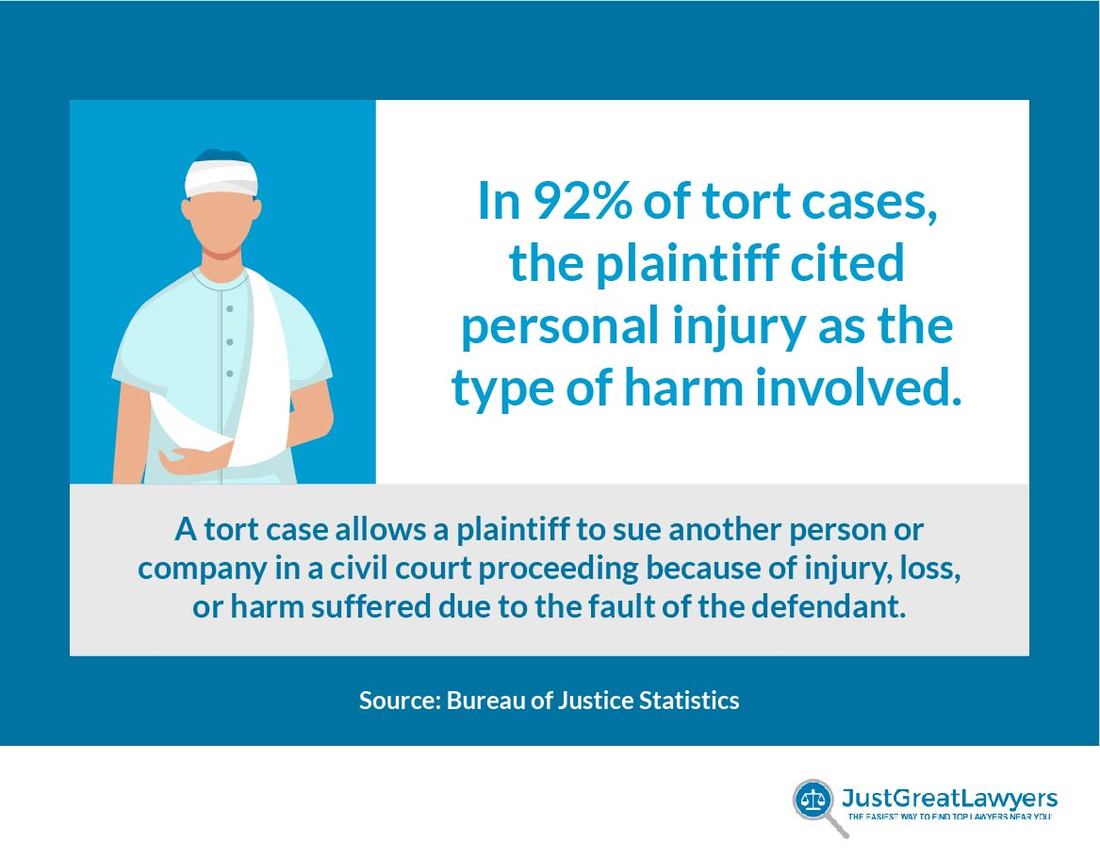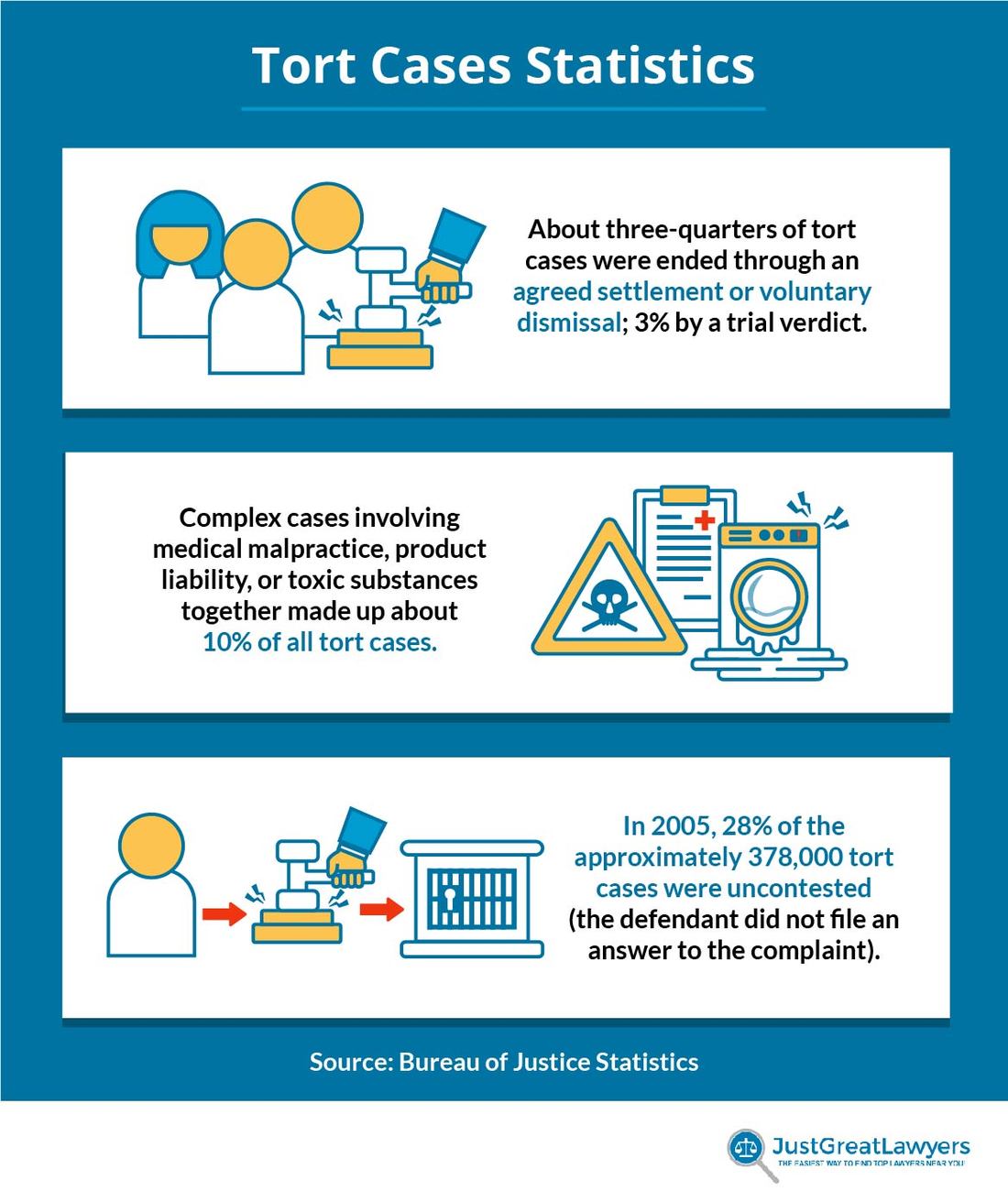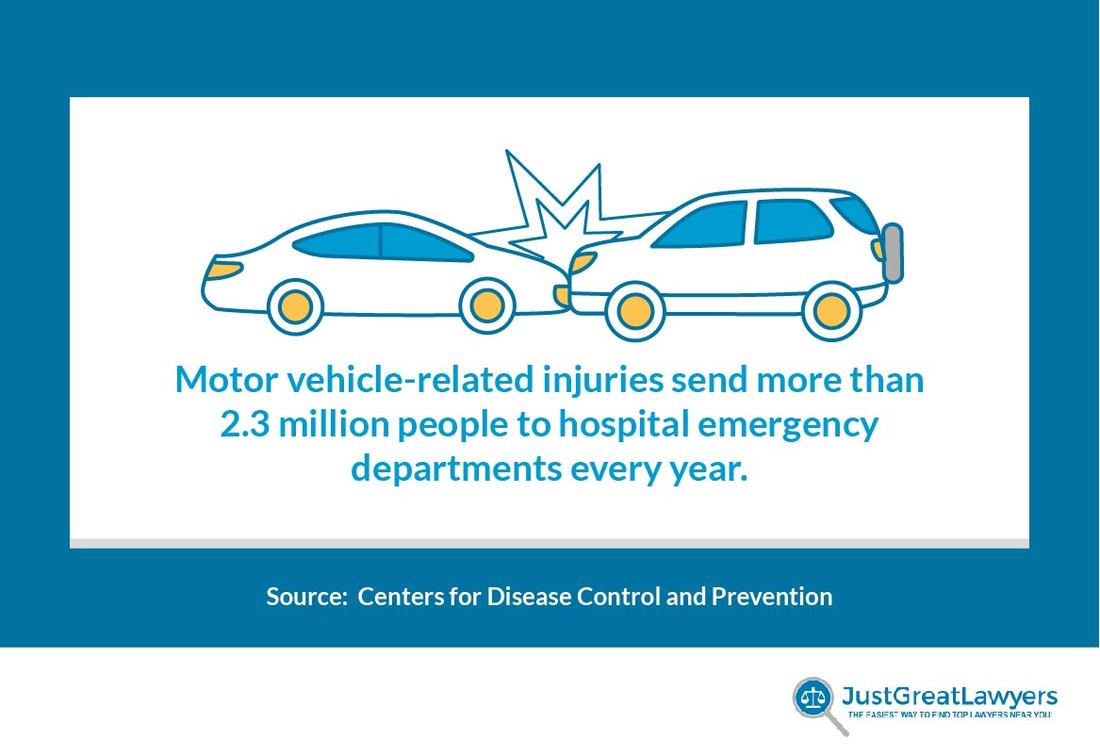
According to the Centers for Disease Control and Prevention (CDC), nearly 175,000 Americans experience unintentional injuries each year. Such injuries rank as the third-leading cause of death, behind cancer and heart disease.
Unfortunately, thousands of injuries occur each day, some of which can lead to personal injury lawsuits. These personal injury statistics explain what types of injuries are most prevalent and how many cases are typically won.

The U.S. Department of Justice, Bureau of Justice Statistics reported that 26,950 real property, contract, and tort trials in 2005 were related to a form of personal injury.
In 92% of tort trials, the plaintiff cited personal injury as the type of harm involved.
Just 5% of personal injury cases end up going to trial. That means 95% are resolved via pretrial settlement.
In cases where a settlement is reached, claims are typically resolved within 9 to 18 months. Cases that go to litigation, however, can take substantially longer.

While 95% percent of personal injury cases are settled before trial, the remaining 5% of people whose cases went to trial faced unpredictable outcomes.
The U.S. Department of Justice reported that the best odds of succeeding at trial were in motor vehicle accidents, at 61%.
In premises liability trials, the odds were just 50-50. (These cases involve the liability of a landowner for an injury that occurred on their property).
The odds were lowest in trials involving product liability, where fewer than 4 in 10, or 38% of plaintiffs were successful.
These figures do not take into account whether the plaintiffs did or did not receive compensation from the case.
The average personal injury settlement amount ranges between $3,000 and $75,000. Keep in mind that this doesn’t include the additional costs to compensate your lawyer, pay fees, and the cost of filing a personal injury case.
In personal injury cases, a lawyer’s contingency fee for representation typically ranges from 33% to 40% of the compensation. That’s in addition to whatever expenses the lawyer incurs while working on your case.
Contingency fees, as opposed to hourly fees, are particularly common in personal injury cases. They are a form of payment that’s based on the amount of monetary damages a plaintiff receives upon winning their case. The lawyer is compensated not only for the time and effort it takes to handle the case, but also for the risk assumed should no settlement be reached or damages awarded.
Lawyers may offer free consultations to determine whether a case has merit and can be settled or won. Contingency fees open up access to legal representation for clients who might not be able to pay an hourly fee. They also provide lawyers with added incentive to obtain monetary compensation for the plaintiffs’ injuries.
If the plaintiff prevails, compensation can be provided in the form of both economic and non-economic damages.
Economic damages would include the cost of any present and future medical care, including hospital stays and rehabilitation. The cost of property damage, such as in a motor vehicle accident, is also in this category. So are lost wages and a reduction in future earning capacity as the result of an injury.
Non-economic damages would involve things like physical pain, emotional anguish, the loss of enjoyment of activities, and loss of relationships (either temporarily or permanently).
If the defendant prevails, the plaintiff will not receive any compensation and must pay fees incurred by the defendant, such as attorney fees, service fees, and the cost of the court filing.
 Motor Vehicle Accidents
Motor Vehicle AccidentsWhile some car accidents result in deaths, others do not. Personal injury cases can be brought in accident cases of either kind.
The National Highway Traffic Safety Administration (NHTSA) estimated that the number of deaths in 2020 from motor vehicle crashes was 38,680 in 2020. That represented a 7.2% increase from the previous year’s figure of 36,096.
Fatalities rose most substantially (9%) among motorcyclists, with the rates for bicyclists and motor vehicle passengers each up 5%.
The numbers were 15% higher on urban interstates, 12% higher on urban collector roads, and up by 11% on rural collector roads.
According to the NHTSA, speeding was involved in 11% more fatalities during 2020 than the year before.
Police-reported alcohol-involved crashes also were more likely, with the number of related deaths rising by 9%.
Contributing factors included poor road infrastructures, unsafe drivers, unenforced traffic accidents/laws, vehicles not up to road standards, and inadequate post-crash medical care. Negligence in auto accidents might include driving too fast for weather conditions, following too closely, driving at night without headlights, failing to signal a turn, texting while driving, running a stop sign or red light, or even driving while tired.
Slips and falls are one of the main causes of unintentional deaths. According to the National Safety Council (NSC), 39,443 people died in falls at home and at work in 2019.
The NSC stated, in the workplace alone, 244,000 American workers were injured badly enough in slips and falls to require days off work, with the median time away from work being eight days.
Factors and personal injuries included such things as:
Wet floors, creating a lack of traction between the surface and a person’s feet.
Feet hitting an object, such as an electrical cord, debris, or nails.
Poor lighting.
Changes in levels, such as stairs.
Job-related activities resulted in 5,333 deaths in 2019, plus a host of other injuries. Cases involving sprains, strains, and tears alone amounted to 295,180 injuries, while back injuries accounted for 136,190 incidents.
Other potential injuries can involve head trauma, broken bones, spinal cord injuries, or other medical-related complications. The construction industry is particularly prone to injury accidents: In 2018, there were 1,008 construction fatalities, including 320 falls to a lower level, the U.S. Bureau of Labor Statistics reported.
A 2018 survey of America’s physicians painted a bleak picture of the people. Medical errors can lead to medical malpractice cases.
According to this survey, 8 in 10 physicians reported working at capacity or being overextended, while 78% said they sometimes, often, or always experience burnout. Nearly half (46%) said they planned to change career paths.
A 2016 survey found that 10% of all U.S deaths are now due to medical errors, with more than 250,000 deaths each year attributed, according to Johns Hopkins patient safety experts.
A relatively small number of physicians are responsible for an outsized number of these claims: Half the malpractice claims in the United States are filed against just 4.8% of the doctors, and 27.5% are filed against just 1.7% of physicians.
The most common reasons for medical malpractice cases come from medical treatments/practices such as:
Diagnostic errors.
Surgery.
Poor monitoring.
Management of medical conditions resulting in patient injury, illness, or death.
About 93% of medical malpractice cases are resolved before trial. The remaining 7% of cases end in a jury verdict.
The plaintiffs’ chances of receiving compensation are much better through settlements than in medical malpractice trials: According to the New England Journal of Medicine, 61% of settlements in medical malpractice cases favored plaintiffs, while the plaintiffs prevailed in just 21% of trial verdicts.
 Although fatalities from dog bites are relatively rare, millions of people are bitten by canines each year, and 800,000 of those victims seek medical attention. About half of those bitten are children between the ages of 5 and 9. Senior citizens and postal carriers are also among high-risk groups.
Although fatalities from dog bites are relatively rare, millions of people are bitten by canines each year, and 800,000 of those victims seek medical attention. About half of those bitten are children between the ages of 5 and 9. Senior citizens and postal carriers are also among high-risk groups.
Overall, there are about 4.7 million dog bites every year in the U.S.
Annually, about 14,025 U.S. citizens require hospitalization for serious dog bite injuries. Dog bite victims account for as many as 5% of emergency room visits in the United States.
Claims against pit bulls account for the majority of fatal attacks in the United States, though this, in part, is due to people mischaracterizing breeds. Between 2005 and 2017, nearly two-thirds (65.6%) of fatal attacks were attributed to pit bulls, followed by rottweilers at 10.4% and German shepherds at 4.6%.
Three times as many hospital stays related to dog bites occurred in rural areas than in urban areas in 2008, and the overall number of stays increased by 86% between 1993 and 2008.
In 2020, homeowners paid out liability claims totaling $854 million for dog bites and other dog-related injuries.
The average cost of a dog-bite-related stay in the hospital was $18,200, which was 50% higher than the average injury-related hospital stay.
Different states have different laws concerning dog bites and liability. Some hold to a strict liability standard, while others impose conditions that make the owner liable only if (for example) the dog is running loose, is known to have vicious propensities, was not provoked, etc. Other states have a “one-bite rule,” which protects the owner from liability unless it has shown a propensity to bite in the past. Still, other states protect the owner if the victim was trespassing.
The District of Columbia uses a contributory negligence standard, so if the victim did anything at all to contribute to the incident, they cannot recover.
Product liability is another cause of unintentional deaths. In 2014, 7% of all personal injury lawsuits were product liability cases. Products ranged from toys to laptop batteries, cars to electric blankets.
Issues that can create product liability include design defects, manufacturing defects, and defects in marketing (such as improper instructions or failure to warn consumers of a product’s latent dangers).
In 47 states, plaintiffs have the burden of proof to demonstrate that a design defect exists; in Alaska, California, and Hawai’i, the burden of proof is on the defendant to show why it is not defective.
Product liability lawsuit cases result in the second-highest damages amounts of all the types of personal injury cases, with the median damage award at around $300,000.
For transportation products, the median compensatory award in 2011 was 10 times that amount, or around $3 million. Median awards in the six or seven figures were also recorded in liability cases involving industrial and construction products ($1.254 million), defective medical products ($1.078 million), defective commercial products ($725,000), and consumer products ($279,000).
Lawsuits can be filed over accidental injuries resulting from defective chemical products, products with safety hazards, and other defective products such as cough medicine.
Cases can lead to large-scale product recalls related to motor vehicles, such as:
Toyota’s recall of more than 1.4 million vehicles in 2006.
A recall of 6.5 million Firestone tires used on Ford Explorers and light trucks in 2000, and 13 million more recalled by Ford the next year at a cost of $3 billion.
General Motors’ recall of 2.6 million small cars over faulty ignition switches in 2014.
Other liability cases in recent years include a recall of 30,000 electric blankets in 2003 after users reported being burned when they were bunched up or folded. More than 200,000 Dell laptop batteries were recalled in 2005 because they were at risk of overheating and causing fires.
Toys can be a particular concern because small parts can become detached and be swallowed by young children, leading to internal injury and even death. Sharp edges are also a concern. In 2003, safety hazards led to the recall of more than 80 toys. And years earlier, in 2001, it was reported that injuries caused by toys hit 255,100.
Even food products can be recalled: In 2008, a salmonella outbreak in peanut products that resulted in 12 deaths and hundreds of illnesses led to the largest food recall in U.S. history. A total of 360 companies and nearly 4,000 products were affected. Early the following year, the Peanut Corp. of America had stopped production and filed for bankruptcy.
There are three potential grounds on which a personal injury claim may be filed.
The most common of these is negligence. Negligence occurs when someone fails to use a level of care that a reasonable person would use under the circumstances. There are two types of negligence:
Contributory negligence: Under the principle of contributory negligence, a plaintiff cannot recover if they had any responsibility in causing an accident. Most jurisdictions no longer recognize this type of negligence.
Comparative negligence: Comparative negligence is when the plaintiff and defendant may each be assigned a percentage of the fault. For example, if a plaintiff proved the defendant was 80% at fault for an accident, the defendant would be responsible for paying 80% of the plaintiff’s damages.
The second basis for a personal injury lawsuit is an intentional wrong or intentional tort. In such cases, someone does something intentionally to harm another, such as assault, false imprisonment, or intentional infliction of emotional distress.
Finally, the standard of strict liability holds defendants liable for their actions without regard to their intent or any negligence. Such cases might involve defective merchandise, which may have caused injury even though the company producing it did not intend to do so and didn’t act negligently in manufacturing it.
These three standards fall under what is known as tort law. (The word “tort” simply means “wrong.”) According to a presidential economic report in 2004, the tort system in the United States is intended to serve two purposes:
Compensate accident victims.
Deter potential defendants from putting others at risk.
The report notes that changes in the law during the 1960s have resulted in more lawsuits being brought under the strict liability standard. This has increased the number of injuries litigated through the tort system.
If you have been injured and believe you have a personal injury law case against a company or individual, it’s a good idea to explore your options as soon as possible so you can ensure you fall within the statute of limitations where you live. That’s because different state courts have different statutes of limitations regarding personal injury cases.
Once a statute of limitations has expired, a would-be plaintiff has no further recourse in the courts. Most states have two- or three-year statutes of limitations, but the statute is five years in Missouri and six years in both Maine and North Dakota. At the other end of the spectrum, the statute is just one year in both Louisiana and Tennessee.
Regardless, the sooner you start investigating your options, the sooner you can receive compensation if you’ve been the victim of a personal injury.
The best thing to do is reach out to a law firm or personal injury attorney and see what can be done.
